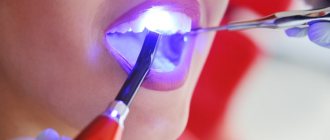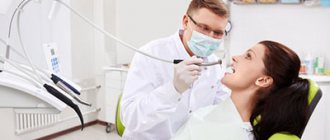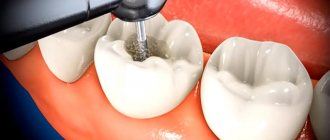Tooth extraction is a very serious procedure, even if it happens quickly and without complications. It always requires increased responsibility on the part of the patient, so it is important to know what rules of care must be followed. The dental surgeon should tell you about them in detail. But to make it easier for you to understand these recommendations, we have systematized them taking into account the specifics of each typical case.
If after tooth extraction the cheek swells and slight swelling appears, then this is considered normal. You should also not be alarmed by mild pain in the tooth socket or an increase in body temperature to 38°C (especially at night). These are all consequences of the inflammatory process. The listed phenomena should disappear on their own after 1-2 days.
Procedure immediately after removal
Tooth extraction is accompanied by a number of activities performed before and after the procedure:
- Do not keep the cotton swab applied by the doctor for longer than 15 minutes. It must be carefully removed so as not to disturb the blood clot. If this is done too late, the wound may become infected, as this is a favorable environment for bacteria to multiply.
- To reduce swelling and relieve pain, apply cold to the cheek, such as ice or frozen food wrapped in a towel. Keep it on your cheek for 5 minutes with constant breaks. Usually 3-5 approaches are enough, but for this, cold water must be applied in the first 4 hours after the removal procedure.
- Sometimes the dentist uses a hemostatic sponge if the bleeding does not stop for a long time. This often happens after wisdom tooth removal. This sponge has an adsorbent, antiseptic, analgesic effect and, in addition, contains the drug alvostasis. It is placed in the hole, and the patient is allowed to perform superficial application only if necessary.
- For severe pain, it is recommended to take painkillers like analgin, tempalgin, spasmalgon, ketanov, ibuprofen, etc. But it is better to consult a dentist about this, since all of the listed medications have a number of contraindications.
- After tooth extraction, you should not drink or eat for 2-4 hours. But it all depends on the complexity of the procedure. So, if several teeth were removed at once or we are talking about a case with suppuration, inflammation or a full-fledged operation with sutures, then this period may be longer. If you really want to drink, you can do this through a straw and in very small sips; optimally, water at room temperature. Under no circumstances should you drink drinks containing alcohol, as it can cause bleeding due to its diluting effect.
- You should not smoke on the day you had a tooth removed, as nicotine has an irritating effect on the tissues of the oral cavity. In addition, each puff involves the formation of a vacuum effect, which poses the risk of dislodging a blood clot and causing a dry socket. If this happens, there is a good chance that you will need medication.
If you have placed a temporary filling
A temporary filling is installed to protect the tooth between procedures and partially restore the function of chewing food.
In the case of using such a seal, there are a number of restrictions:
- 1
It is necessary to refuse food for at least 2 hours. - 2
Do not eat hot or cold food.
- 3
Use caution when brushing your teeth.
- 4
Avoid chewing gum and sticky, chewy foods such as caramel.
A temporary filling is not very durable, so you should chew food on the opposite side of your mouth before installing a permanent one. The answer to the question of how much you can’t eat after a temporary filling is given by your dentist. It depends on the location of the filling, its strength and complexity.
Home care
After surgery, you can take antiseptic baths on the first day. To do this, you can use furatsilin, chlorhexidine 0.05% or another antiseptic as prescribed by a doctor.
On the second day, you can already brush your teeth using a soft brush. Be careful not to touch the tooth socket, which should still contain a blood clot. After cleaning, you need to rinse the brush in an antiseptic and place it in a sterile place. On the same day, you can take warm baths based on sea salt. To do this, you need to dilute half a tsp. salt in 250-300 ml of water and add 0.25 tsp. soda
Sometimes doctors recommend baths with decoctions for healing. This can be oak bark, elecampane, sage, St. John's wort, chamomile and other plants.
What not to do?
The postoperative period after tooth extraction is 5-7 days. At this time, you need to be attentive to your health, measure your temperature, and monitor for bleeding. If the pain persists for more than 2 days or intensifies (or becomes throbbing), you should contact your dentist.
Over time, healthy tissue forms at the site of the blood clot, but this can be disrupted if the area is not properly cared for. After tooth extraction surgery it is not recommended to:
- Taking anticoagulants because they thin the blood.
- Bathing in a hot bath, visiting a bathhouse and sauna. Sudden changes in temperature can be harmful, as they cause spasms or dilate the lumen of blood vessels. As a result, the pain will intensify and bleeding may resume.
- Rinsing the mouth.
- Drinking alcoholic beverages.
- Smoking.
- Spitting, as this may dislodge the blood clot.
- Treatment of other teeth, including caries, earlier than a week after extraction. As a result, infection can occur, since carious teeth contain many bacteria.
- Strenuous physical activity, especially heavy lifting and bending. This is one of the reasons for increased blood pressure, which serves as a provoking factor for the opening of bleeding.
- Chewing food on the “sick” side of the dentition.
- Active facial expressions. If there are sutures in the oral cavity, they can break and even come apart.
Why are there any restrictions after installing a filling? [1]
After installing a filling, basic recommendations are given in order to prevent possible negative effects of food or the chewing process on the newly filled tooth. These include advice on whether and when to eat after dental treatment.
- Restrictions on food intake after installation of a filling, related directly to the treatment[1]
- When treating teeth, local anesthesia , which can reduce sensitivity not only at the site of injection of the anesthetic drug, but throughout the entire oral cavity. As a result, a person incorrectly estimates the size of a piece of food and the degree of grinding. This increases the risk of biting the lips and tongue, trauma to the mucous membranes, breathing problems, and swallowing.
- In the area of manipulation (tooth, periodontium), intervention is performed with instruments. The body’s natural reaction to this is the development of minor inflammation and increased sensitivity, which affect how much you can’t eat after installing a filling: chewing food often leads to discomfort and pain.
- A fresh filling may slightly irritate the soft tissue and nerve inside the tooth. Therefore, if you accidentally press on a newly treated tooth, pain may occur. It can persist for several days, but in the first hours the greatest discomfort is felt.
- While eating, cool air enters the oral cavity. It often causes irritation and increases pain, especially when anesthesia wears off. Such discomfort causes stress, increases irritability and nervousness. Patients try to eliminate discomfort by touching the filled tooth with their tongue, and thereby increase the risk of poor adhesion (attachment) of the filling.
- Related to the characteristics of the material from which the filling is made [1]
Composite materials may change color when exposed to natural and artificial colors in food or beverages. To prevent this from happening, dentists advise avoiding eating brightly colored foods for at least the next two days after installing a light filling. These products include:- berries;
tea;
- coffee;
- carbonated drinks;
- caramel;
- candies in colored glaze, etc.
Information on the use of drugs
If the procedure was not complicated, it is quite possible that painkillers will not be needed during the recovery period. But it’s better to take an analgesic half an hour before the end of the anesthesia (the doctor will tell you about the approximate time). This will help prevent pain, which is almost inevitable after a complex removal, accompanied by drilling the bone, opening an abscess, cutting out affected tissue, suturing, etc. Drugs such as ketanov, nimesil, nimik, etc. will help you quickly cope with pain. Among other things, they also have an anti-inflammatory effect.
The patient must inform the doctor about his state of health and existing diseases. This is especially important when it comes to arterial hypertension, diabetes, hemophilia, and low platelet levels in the blood. Your dentist should also know if you have a tendency to nosebleeds or have recently had an acute respiratory infection or the flu. In this case, the specialist selects individual methods for caring for the hole.
How to maintain a healthy and white smile
Proper nutrition helps maintain healthy teeth and improves their condition. In addition, as we indicated above, it is able to maintain the effect after professional whitening.
But, of course, proper nutrition alone will not help you maintain a snow-white smile. It must be combined with careful oral hygiene. This will not only strengthen your teeth, but also help strengthen the overall immunity of the body.
To ensure that your care is as effective as possible, use high-quality professional products.
A series of professional dental care products “Asepta”
“Asepta” is a wide range of oral care solutions that allows you to solve problems with bleeding and inflammation of the gums, pathogens, and increased sensitivity of teeth. This is a great way to maintain a high level of oral hygiene and ensure disease prevention.
- ASEPTA ACTIVE is a therapeutic and prophylactic paste for gentle cleansing of the oral cavity and comprehensive protection of gums and teeth. Effectively strengthens enamel, soothes gums and gives fresh breath.
- ASEPTA PLUS REMINERALIZATION is designed specifically to strengthen weakened enamel. The thermal mud included in its composition and hydroxyapatite quickly restore the health of weakened teeth.
- ASEPTA PLUS GENTLE WHITENING is an effective system for gentle whitening. The result is noticeable within four weeks. The paste prevents the occurrence of increased tooth sensitivity, mineralizes the enamel and ensures rapid restoration of the oral mucosa.
In addition to pastes, the Asepta series includes mouth rinses, balms, gels and vitamins for teeth.
Features of care after wisdom tooth removal
After the wisdom tooth removal procedure, you must adhere to the same general recommendations regarding socket care.
- Relax
- Do not eat solid food or chew on the area where the tooth was.
- Do not rinse your mouth and try not to spit for 24 hours so as not to dislodge the tampon.
- No smoking for 48 hours
- Don't suck in anything
- Do not create a vacuum in the mouth
For such cases, the recovery period is 2 weeks. At this time, a foreign body may be felt in the hole, since it contains medications for healing and suture material. Often, after the removal of a wisdom tooth, the body temperature rises in the evening. Periodic pain in this area is also considered normal. It is sometimes projected onto the ear and cheekbones.
To eliminate the risk of developing pathologies, you should take antibiotics prescribed by a dental surgeon. Typically, the list of approved drugs includes lincomycin, flemoxin and tsifran. The use of anti-inflammatory drugs such as rotokan and compresses is also recommended. Their effect can be enhanced by applications with agents that prevent the growth of bacteria. Before going to bed and every time after eating, you can do a light and very gentle rinse. In two weeks, all unpleasant consequences should pass. If this does not happen, you should definitely visit the dentist.
Advice for pregnant women
In the case of pregnant women, the list of acceptable analgesics and antiseptic drugs is noticeably reduced. You cannot take medications at your own discretion! They should only be prescribed by a doctor. Also during this period, the use of baths, cold compresses and applications with herbal infusions is allowed.
What to do if pain persists for a long time after a filling is installed? [1]
After installing the filling and the end of the acute period, sensitivity may increase during eating and chewing food within 1-2 weeks. It is recommended to put less stress on the filled tooth and chew on the other side of the jaw. If discomfort persists for more than 14 days, you should contact a dental clinic to identify the cause and obtain advice. If acute pain occurs, without pressure or stress on the treated tooth, then you need to contact the dentist as soon as possible.
Medical expert: Oleg Sergeevich Shchekin
Last updated: July 21, 2021
When do you need to see a doctor urgently?
If a high temperature (more than 38 degrees) lasts longer than a day, and severe swelling is observed, accompanied by an unpleasant odor and taste in the mouth, a doctor’s consultation is necessary. You should immediately see a doctor if the bleeding does not stop for more than 10 hours.
Also reasons to contact a specialist are:
- external signs of seam divergence;
- the appearance of pain in the socket that does not subside for more than 3 days, increasing or pulsating;
- mobility of adjacent teeth;
- numbness of the tongue, cheeks and lips;
- soreness of the submandibular lymph nodes.
Do not ignore the recommendations described above, as this can lead to serious complications and long-term treatment, including in a hospital setting.











